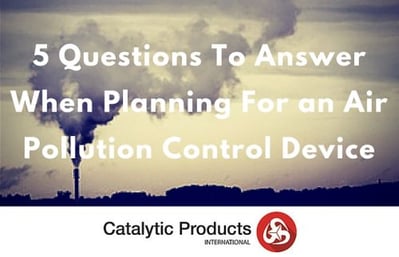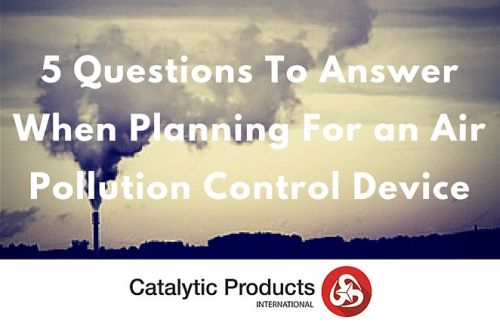 Air pollution control is a complicated subject, but it is incredibly important for any company that uses industrial processes to understand how to manage the volatile organic compounds (VOCs) and hazardous air pollutants (HAPs) that they produce. But before companies proceed with planning and budgeting for an air pollution control device, there are several questions they need to answer:
Air pollution control is a complicated subject, but it is incredibly important for any company that uses industrial processes to understand how to manage the volatile organic compounds (VOCs) and hazardous air pollutants (HAPs) that they produce. But before companies proceed with planning and budgeting for an air pollution control device, there are several questions they need to answer:
1. What does your facility manufacture?
When working with a company like CPI to purchase and install an air pollution control device, you’ll need to provide us with information about your process in order for us to determine exactly what kind of pollution control device will be required. Understanding what processes and materials are used in your facility will provide the knowledge that ensures the right type of pollution control device is used and that it operates at the maximum level of efficiency.
2. Do you currently own an air pollution control device or oxidizer?
If your facility is currently using an air pollution control device, understanding its purpose and specifications can help provide information about the type of pollution control that is needed. You’ll want to gather the following information:
- Who is the manufacturer?
- What type of device is it?
- How old is it?
- Who services it?
- Are you replacing it or going through an expansion?
Understanding the answers to these background questions, as well as the more detailed technical questions (that you can find on our quote request form), will help ensure that your new or expanded air pollution control device is able to meet your needs going forward.
3. Are you being required to purchase and install an oxidizer by the EPA, or upgrading a current air pollution control device?
Depending on whether you are planning to use an air pollution control device to meet EPA requirements or if you are upgrading a current air pollution control device to improve efficiencies, your needs may be different. If you need to meet EPA requirements, you’ll need to be aware of exactly what those requirements are and how your air pollution control systems are able to meet them (see our white paper on permitting and regulatory developments to learn more). When installing a new air pollution control device, you will also want to be aware of any upcoming changes to regulations to ensure you meet those requirements as well and won’t need to make upgrades soon after the install. A partner like CPI can help you answer these questions and ensure that your facility’s needs are met.
4. What kind of timeframe are you considering?
The process for planning, delivering, and installing an air pollution control device is complicated, involving gathering technical requirements, securing funding, installation, and certification, and the entire process can take anywhere from nine months to one year. Understanding both the “big picture” timeframe for installing your air pollution control device and the amount of time needed for each individual step of the process is important, and it will ensure that you are able to complete the project on time and within your budget.
5. What stage of the process are you currently in?
Are you just getting started with the process of planning and budgeting for an air pollution control device? Have you determined your budget and secured funding? Have you determined the required specifications? Do you need to review qualified vendors and their proposals? No matter which stage of the process you are in, we can help you determine what you need to do next, how you can ensure that your air pollution control systems will meet the needs of your facility, and how to plan the right budget for the remainder of the project.
Collaborating with an experienced air permitting consultant familiar with state and federal regulations is crucial for the successful planning and installation of an air pollution control device. An expert can effectively navigate the complex regulatory landscape, which includes programs like the Clean Air Act, New Source Review (NSR), and state-specific rules. This guidance helps prevent costly project delays and fines that can result from permitting errors or non-compliance. Consultants can also devise a strategic approach to secure flexible permit conditions and streamline the entire process, including emissions calculations, technology evaluations, and application development. Working together with a consultant ensures the project meets all compliance requirements, safeguarding against financial penalties and future regulatory complications.
Please contact us if you have any questions; we look forward to helping you navigate through the planning process.








